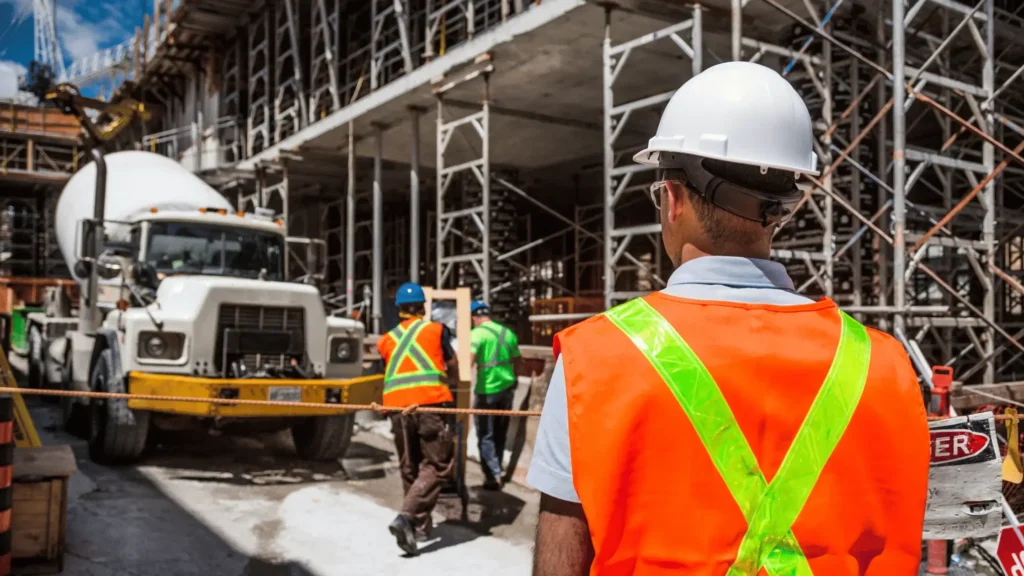Staying safe on a construction site isn’t just good practice. It’s what keeps workers alive.
Every job comes with risks. But construction sites? They’re packed with hazards. Falls. Heavy machinery. Sharp tools. Electricity. Dust. Noise. The list goes on.
Most of it can be managed. But only if workers follow the rules. Proper training helps. So does looking out for each other.
This blog gives ten key safety tips every worker should know. It’s not just about ticking boxes. It’s about going home in one piece.
1. Wear the Right PPE
No gear. No job. It’s that simple.
PPE keeps workers safe from head to toe. Think helmets, gloves, boots, hi-vis vests, goggles, ear protection. Each piece matters. Skip one, and it could cost more than a day’s work.
Workers should check their gear before every shift. Torn gloves? Replace them. Damaged helmet? Get a new one. Fit matters too. Loose goggles or oversized boots are just as risky as having none.
Supervisors should enforce it. Workers should own it.
2. Attend Safety Inductions and Toolbox Talks
Sites change fast. So do risks.
Safety inductions show workers what to expect. Toolbox talks cover updates. Everyone must attend. No exceptions.
New starters get the basics. Old hands get reminders. Topics might seem obvious. But the point is to keep safety fresh.
These sessions often come with useful reminders found in health and safety training courses. Skipping them isn’t clever. It’s dangerous.
3. Keep Work Areas Clean and Organised
Mess kills. Literally.
Loose tools, tangled cables, scattered debris. One wrong step can send someone to A&E. A tidy site is a safer site.
Workers should be clear as they go. No waiting till the end of the shift. Rubbish goes in skips. Tools go back in place. Spills get cleaned right away.
It’s simple. Stay neat. Stay safe.
4. Use Tools and Machinery Properly
Wrong use. Bad results.
Every machine has a purpose. Every tool has a way it should be used. Guessing is not an option.
Workers must be trained. Must follow instructions. Must report faults. Never force a jammed saw. Never remove guards from a grinder.
Even hand tools can cause real harm when misused. Knowing the right way to use equipment isn’t just smart. It’s survival.
5. Watch for Falling Objects
Heads aren’t made of steel.
Tools dropped from scaffolding. Materials slipping off ledges. Wind catching unsecured items. A falling object doesn’t have to be big to cause serious injury.
Helmets help. But staying alert helps more. Workers should never walk under suspended loads. Never leave tools near edges. Always secure items when working at height.
It’s about being aware. A few seconds of caution can stop a lifetime of damage.
6. Follow Safe Lifting Techniques
Back pain doesn’t go away. Not quickly. Sometimes not ever.
Construction work often means lifting. Bricks. Tools. Boards. Bags of cement. The wrong move can put someone out of work for weeks.
Lift with the legs, not the back. Keep loads close. Don’t twist. Don’t rush. If it’s too heavy, ask for help. Or use a trolley.
Training helps, but it’s the habit that saves the spine.
7. Stay Aware of Site Hazards
A busy site is full of danger. Some seen. Some not.
Moving vehicles don’t always make noise. Trenches can be open. Cables might run underfoot. Not every danger shouts.
Workers should always know what’s going on around them. Watch where they step. Look before they move. Stop and think before entering a new area.
Markings, signs, barriers — they’re not decoration. They’re survival tools.
8. Use Ladders and Scaffolding Safely
A fall from two metres can kill.
Ladders should be on firm ground. Always locked in place. Never climb while carrying tools. Three points of contact — that’s the rule.
Scaffolding needs regular checks. No broken boards. No missing guardrails. No gaps to trip over.
Most of this is covered in online construction safety courses. It’s basic stuff. But one mistake is all it takes.
9. Know Emergency Procedures
Fires. Collapses. Accidents. Emergencies don’t wait.
Every worker must know what to do. Where the exits are. Where the fire extinguishers are. Who the first aiders are.
It’s not just about drills. It’s about being ready for real-life panic. When things go wrong, seconds matter.
Every new site means new exits, new risks. Workers must ask if they don’t know. Guessing is not an option.
10. Report Unsafe Conditions Immediately
See something off? Say something fast.
Wobbly handrails. Leaks. Exposed wires. Unmarked holes. Small issues grow quickly on a building site.
Reporting keeps everyone safe. Delaying it doesn’t. It takes one report to stop an accident. Or save a life.
Supervisors must listen. But workers must speak up.
Leave Safe, Come Back Safe
Construction is hard. Long hours. Tough work. Heavy gear. Loud sites. But none of it matters if workers don’t go home at the end of the day.
Safety isn’t a box to tick. It’s what keeps bones unbroken. Keeps lives on track. These ten tips aren’t extras. They’re the basics. The bare minimum.
It’s not just the company’s job. It’s not just the safety officer’s job. It’s everyone’s.
So wear the gear. Use the tools right. Stay sharp. Speak up. Follow the training. Follow the signs.
Work smart. Stay safe. Go home in one piece. Every day.

